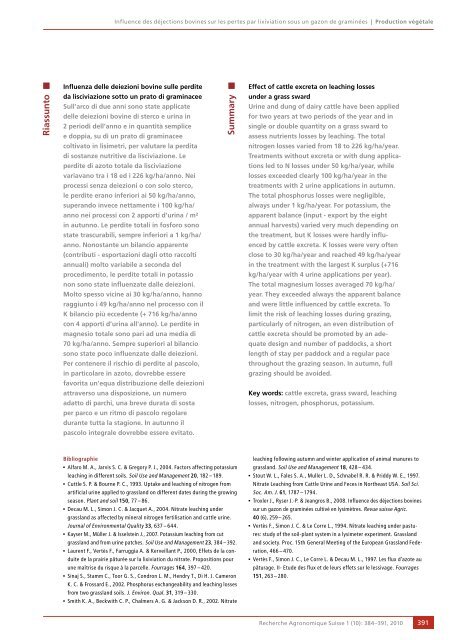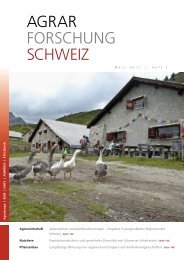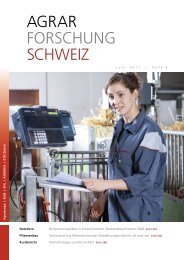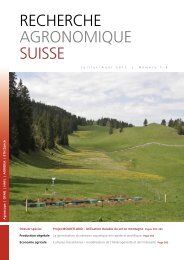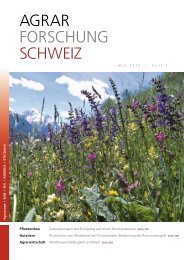Télécharger le PDF - Agrarforschung Schweiz
Télécharger le PDF - Agrarforschung Schweiz
Télécharger le PDF - Agrarforschung Schweiz
Create successful ePaper yourself
Turn your PDF publications into a flip-book with our unique Google optimized e-Paper software.
Riassunto<br />
Influence des déjections bovines sur <strong>le</strong>s pertes par lixiviation sous un gazon de graminées | Production végéta<strong>le</strong><br />
Influenza del<strong>le</strong> deiezioni bovine sul<strong>le</strong> perdite<br />
da lisciviazione sotto un prato di graminacee<br />
Sull’arco di due anni sono state applicate<br />
del<strong>le</strong> deiezioni bovine di sterco e urina in<br />
2 periodi dell’anno e in quantità semplice<br />
e doppia, su di un prato di graminacee<br />
coltivato in lisimetri, per valutare la perdita<br />
di sostanze nutritive da lisciviazione. Le<br />
perdite di azoto tota<strong>le</strong> da lisciviazione<br />
variavano tra i 18 ed i 226 kg/ha/anno. Nei<br />
processi senza deiezioni o con solo sterco,<br />
<strong>le</strong> perdite erano inferiori ai 50 kg/ha/anno,<br />
superando invece nettamente i 100 kg/ha/<br />
anno nei processi con 2 apporti d’urina / m²<br />
in autunno. Le perdite totali in fosforo sono<br />
state trascurabili, sempre inferiori a 1 kg/ha/<br />
anno. Nonostante un bilancio apparente<br />
(contributi - esportazioni dagli otto raccolti<br />
annuali) molto variabi<strong>le</strong> a seconda del<br />
procedimento, <strong>le</strong> perdite totali in potassio<br />
non sono state influenzate dal<strong>le</strong> deiezioni.<br />
Molto spesso vicine ai 30 kg/ha/anno, hanno<br />
raggiunto i 49 kg/ha/anno nel processo con il<br />
K bilancio più eccedente (+ 716 kg/ha/anno<br />
con 4 apporti d’urina all'anno). Le perdite in<br />
magnesio tota<strong>le</strong> sono pari ad una media di<br />
70 kg/ha/anno. Sempre superiori al bilancio<br />
sono state poco influenzate dal<strong>le</strong> deiezioni.<br />
Per contenere il rischio di perdite al pascolo,<br />
in particolare in azoto, dovrebbe essere<br />
favorita un’equa distribuzione del<strong>le</strong> deiezioni<br />
attraverso una disposizione, un numero<br />
adatto di parchi, una breve durata di sosta<br />
per parco e un ritmo di pascolo regolare<br />
durante tutta la stagione. In autunno il<br />
pascolo integra<strong>le</strong> dovrebbe essere evitato.<br />
Summary<br />
Bibliographie<br />
b Alfaro M. A., Jarvis S. C. & Gregory P. J., 2004. Factors affecting potassium<br />
<strong>le</strong>aching in different soils. Soil Use and Management 20, 182 – 189.<br />
b Cutt<strong>le</strong> S. P. & Bourne P. C., 1993. Uptake and <strong>le</strong>aching of nitrogen from<br />
artificial urine applied to grassland on different dates during the growing<br />
season. Plant and soil 150, 77 – 86.<br />
b Decau M. L., Simon J. C. & Jacquet A., 2004. Nitrate <strong>le</strong>aching under<br />
grassland as affected by mineral nitrogen fertilisation and catt<strong>le</strong> urine.<br />
Journal of Environmental Quality 33, 637 – 644.<br />
b Kayser M., Mül<strong>le</strong>r J. & Isselstein J., 2007. Potassium <strong>le</strong>aching from cut<br />
grassland and from urine patches. Soil Use and Management 23, 384 – 392.<br />
b Laurent F., Vertès F., Farruggia A. & Kerveillant P., 2000, Effets de la conduite<br />
de la prairie pâturée sur la lixiviation du nitrate. Propositions pour<br />
une maîtrise du risque à la parcel<strong>le</strong>. Fourrages 164, 397 – 420.<br />
b Sinaj S., Stamm C., Toor G. S., Condron L. M., Hendry T., Di H. J. Cameron<br />
K. C. & Frossard E., 2002. Phosphorus exchangeability and <strong>le</strong>aching losses<br />
from two grassland soils. J. Environ. Qual. 31, 319 – 330.<br />
b Smith K. A., Beckwith C. P., Chalmers A. G. & Jackson D. R., 2002. Nitrate<br />
Effect of catt<strong>le</strong> excreta on <strong>le</strong>aching losses<br />
under a grass sward<br />
Urine and dung of dairy catt<strong>le</strong> have been applied<br />
for two years at two periods of the year and in<br />
sing<strong>le</strong> or doub<strong>le</strong> quantity on a grass sward to<br />
assess nutrients losses by <strong>le</strong>aching. The total<br />
nitrogen losses varied from 18 to 226 kg/ha/year.<br />
Treatments without excreta or with dung applications<br />
<strong>le</strong>d to N losses under 50 kg/ha/year, whi<strong>le</strong><br />
losses exceeded c<strong>le</strong>arly 100 kg/ha/year in the<br />
treatments with 2 urine applications in autumn.<br />
The total phosphorus losses were negligib<strong>le</strong>,<br />
always under 1 kg/ha/year. For potassium, the<br />
apparent balance (input - export by the eight<br />
annual harvests) varied very much depending on<br />
the treatment, but K losses were hardly influenced<br />
by catt<strong>le</strong> excreta. K losses were very often<br />
close to 30 kg/ha/year and reached 49 kg/ha/year<br />
in the treatment with the largest K surplus (+716<br />
kg/ha/year with 4 urine applications per year).<br />
The total magnesium losses averaged 70 kg/ha/<br />
year. They exceeded always the apparent balance<br />
and were litt<strong>le</strong> influenced by catt<strong>le</strong> excreta. To<br />
limit the risk of <strong>le</strong>aching losses during grazing,<br />
particularly of nitrogen, an even distribution of<br />
catt<strong>le</strong> excreta should be promoted by an adequate<br />
design and number of paddocks, a short<br />
<strong>le</strong>ngth of stay per paddock and a regular pace<br />
throughout the grazing season. In autumn, full<br />
grazing should be avoided.<br />
Key words: catt<strong>le</strong> excreta, grass sward, <strong>le</strong>aching<br />
losses, nitrogen, phosphorus, potassium.<br />
<strong>le</strong>aching following autumn and winter application of animal manures to<br />
grassland. Soil Use and Management 18, 428 – 434.<br />
b Stout W. L., Fa<strong>le</strong>s S. A., Mul<strong>le</strong>r L. D., Schnabel R. R. & Priddy W. E., 1997.<br />
Nitrate Leaching from Catt<strong>le</strong> Urine and Feces in Northeast USA. Soil Sci.<br />
Soc. Am. J. 61, 1787 – 1794.<br />
b Trox<strong>le</strong>r J., Ryser J.-P. & Jeangros B., 2008. Influence des déjections bovines<br />
sur un gazon de graminées cultivé en lysimètres. Revue suisse Agric.<br />
40 (6), 259 – 265.<br />
b Vertès F., Simon J. C. & Le Corre L., 1994. Nitrate <strong>le</strong>aching under pastures:<br />
study of the soil-plant system in a lysimeter experiment. Grassland<br />
and society. Proc. 15th General Meeting of the European Grassland Federation,<br />
466 – 470.<br />
b Vertès F., Simon J. C., Le Corre L. & Decau M. L., 1997. Les flux d’azote au<br />
pâturage. II- Etude des flux et de <strong>le</strong>urs effets sur <strong>le</strong> <strong>le</strong>ssivage. Fourrages<br />
151, 263 – 280.<br />
Recherche Agronomique Suisse 1 (10): 384–391, 2010<br />
391


